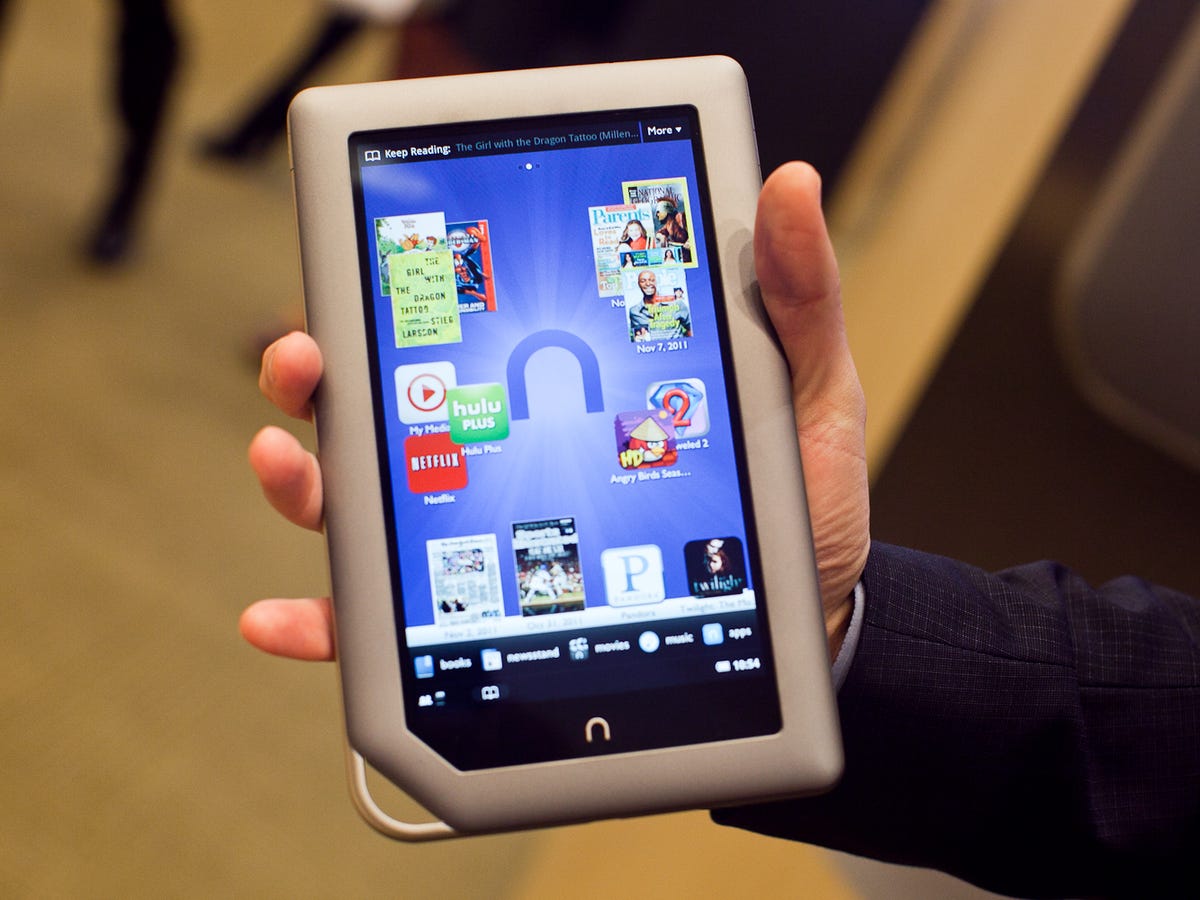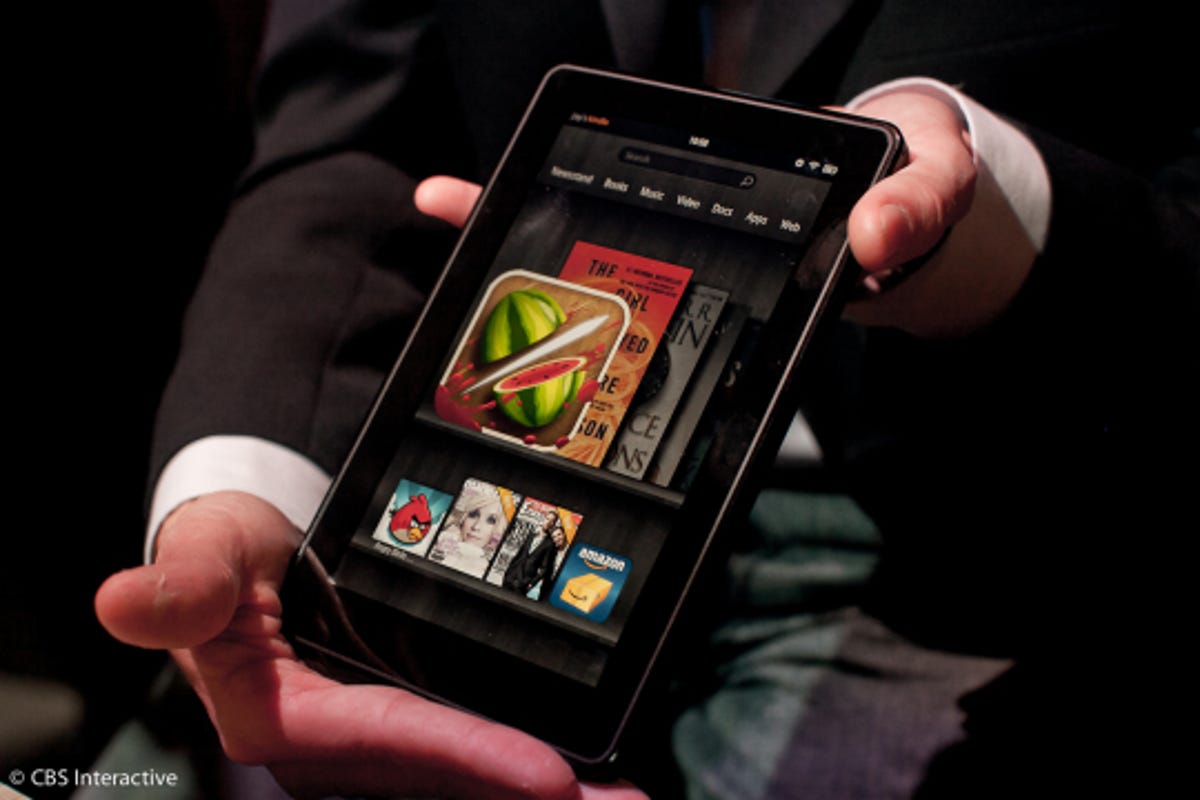

Now playing:
Watch this:
Kindle Fire vs. Nook Tablet
5:25
Editors’ note: This article was originally posted November 23, 2011. We’ve added some material and updated it on February 24, 2012, based on further use of the products and the introduction of Barnes & Noble’s 8GB Nook Tablet.
Now that the Amazon Kindle Fire and the Barnes & Noble Nook Tablet both have a few months under their belts, we’re taking another look at these two budget-price tablets.
Related stories
- Amazon Kindle Fire review
- Barnes & Noble Nook Tablet review
- Is the Fire’s 8GB of storage enough?
- E-ink readers: Kindle vs. Nook vs. iPad
Even after a handful of software updates from both manufacturers, we’re still awarding the Nook Tablet a slightly higher rating, thanks largely to its hardware advantages: a better screen, expandable storage, and the inclusion of some convenient physical controls such as a volume control and a home key.
So, does that mean you should definitely choose the Nook Tablet over the Kindle Fire?
The answer, somewhat frustratingly, is, “It depends.”
To help clarify which device is best for each consumer, here’s a quick breakdown.

Sarah Tew/CNET
Buy the Nook Tablet if you value…
The screen: The Nook Tablet’s screen uses the same 1,024×600-pixel resolution found on the Kindle Fire, but it looks better to our eyes. Just like on the Nook Color, Barnes & Noble made an effort to eliminate the gap between the LCD panel and the glass above it, giving images and text a crisper look. Apps also appear to fit the screen’s resolution better than on the Kindle Fire, perhaps because of the differences in how the devices eat into the screen real estate with their own menus and navigation elements. The Netflix app, in particular, looks much better on the Nook Tablet than on the Kindle Fire, though this may change as updates roll out.
Room to expand: Yes, it’s annoying that the Nook Tablet doesn’t hand over all of its storage capacity to user content. The 8GB version only reserves 4GB of space for dragged-and-dropped user content (basically audio and
video files), while the 16GB model currently offers only 1GB of storage for user content. Barnes & Noble has stated that owners of the 16GB model will be offered an option mid-March to increase the Nook Tablet’s memory allocation up to 8GB for side-loaded content.
No matter how you slice it, Nook Tablet owners have the option to invest $15 to $25 in a removable microSD card, allowing up to 32GB of your own content.


Now playing:
Watch this:
Barnes & Noble Nook Tablet (8GB)
3:51
Kids’ books: Barnes & Noble has championed color e-books for kids since the introduction of the Nook Color in 2009. The Nook Tablet’s integrated microphone allows parents to record as they read to their children.
Magazines: The selection of subscription and single-issue magazines on the Nook Tablet looks better than what’s available through Amazon. Most of the available magazines preserve the design of the print edition’s layout, creating a reading experience closer to the real thing.
A more traditional tablet interface: As with most Android tablets, the Nook Tablet’s home screen acts like a virtual desktop that you can customize with your favorite items and spread across multiple pages. The Kindle Fire doesn’t allow as much home screen customization, though some may prefer the simplicity of its one-page home screen.
Battery life: Battery testing is still in progress but it would seem that Barnes & Noble has a decisive lead.
In-store service and benefits: Walk into any Barnes & Noble store with your Nook Tablet and you can take advantage of pricing specials, book previews, free Wi-Fi, and in-person support.
Nook Tablet (photos)






Reasons to avoid the Nook Tablet
Price: You can save money by buying the $199 8GB Nook Tablet, but it comes at the cost of extra storage, and half the system RAM–features that really helped set Nook Tablet apart. That said, the $50 premium you’re paying for the 16GB Nook Tablet isn’t chump change. Read CNET’s “Is the 8GB Nook Tablet Worth $200?” for a more in-depth take on the merits of Barnes & Noble’s two Nook Tablets.
No video download service: It’s easy to get music onto the Nook Tablet–just drag and drop tracks you buy from iTunes (or even Amazon.com). Video is another story. While there are great streaming apps like Netflix and Hulu Plus, there’s currently no legal way to rent or purchase video files on the device for those frequent times when you
don’t have reliable Wi-Fi Internet access, such as on a long flight. This may change in the future–possibly with the addition of Vudu or a similar app–but for now, the Kindle Fire has the edge here.
No Amazon Prime-style membership advantage: Buying or renewing a B&N Membership ($25 per year) entitles you to that same amount deducted from the purchase of a Nook Tablet or Nook Color. Members are also
entitled to in-store and online discounts and free shipping for print books, but no other tangible benefits for using the Nook itself. Compare that with the Amazon Prime benefits listed below.
Required charging adapter: It’s annoying that you have no option but to use the included power adapter to charge the Nook Tablet. If you lose it, you’ll need to buy a new one from Barnes & Noble. In fairness, it’s best to charge the Kindle Fire with its included power adapter, but it’s at least possible to charge it using a generic Micro-USB cable.


Buy the Kindle Fire if you value…
Amazon Prime: “Free” videos and books (Kindle Owners’ Lending Library) and free two-day shipping on Amazon orders are included for the first month at no cost, but it costs $79 per year to maintain. If you’re already hooked on Amazon’s Prime service then the Kindle Fire is an easy recommendation to make.
Customized interface: The Kindle Fire’s radically simple user interface behaves nothing like a smartphone or a computer, and for many, that’s a good thing.
Cloud access to everything: For the Kindle Fire, the “cloud” is more than just a promise to let users redownload their purchased content. Customers are given a free 5GB Cloud Drive account to which they can upload any music, photos, videos, or documents they want access to. Additional cloud storage can be purchased at reasonable rates.
Offline video downloads: Some, though not all, of Amazon’s digital video library can be downloaded for offline playback.
Amazon Kindle Fire screenshots






Reasons to avoid the Kindle Fire
Not much storage space: Books and documents take up very little room, but if you have your heart set on stocking the Kindle Fire with your personal music and video library, you should keep your expectations low. The maximum amount of video content we were able to successfully load onto the Kindle Fire was 5GB. Depending on the resolution of the video files involved, that could be three or four 720p movies or a season’s worth of a standard-definition TV show. Either way, the Nook Tablet is designed to accept up to 32GB of microSD card storage, and is a clear winner when it comes to file hoarding.
Hardware compromises: There is nothing we love about the Kindle Fire’s design. The screen isn’t quite as pretty as the Nook Tablet’s, there are no hardware controls for volume, the power button is awkwardly placed, and the whole thing looks like a chunky version of 2010’s Samsung Galaxy Tab. Under the hood, you have half the RAM of the 16GB Nook Tablet, half the storage, no integrated microphone, and no memory expansion.
Needs persistent Web access: The cloud is great–if you’ve always got access to it. When you’re out of range, you can still enjoy your locally stored content, but many of the Kindle Fire’s best features are unavailable without a connection to the Internet.
Prime membership: Great benefits such as the Kindle Owners’ Lending Library and Instant Video are only available to Amazon Prime members. You get a month free, but after that it’s $79 per year.
Parting thoughts
These are both promising tablets offered at great prices, but the current tablet market is much more competitive than it was at this time last year, when the groundbreaking Nook Color was released. We expect both products will continue to improve as new apps, services, and software updates are added. In the meantime, use the guidelines above to figure out which is best for you or your gift recipient of choice.



